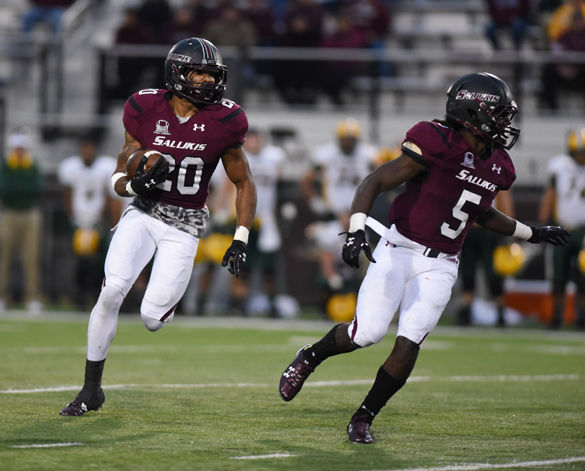Salukis using speed to scorch defenses

November 4, 2015
Football teams have a variety of options when it comes to an offensive attack. Depending on roster composition, teams can choose to pound the ball at opponents with a power running game or air it out with deep passes.
Co-offensive coordinator Nick Hill calls wideout sweeps and outside screen passes to get the ball to the field’s edge, using the receivers’ speed to beat defenders.
These plays are often called with a formation using four receivers out wide and a running back next to the quarterback in shotgun formation.
Advertisement
A wideout sweep starts with a receiver motioning across the field before the snap. Before he passes the quarterback, the ball is snapped and handed to the receiver. He runs to the outside where his teammates are blocking.
The play is commonly known as a jet sweep because the wideout’s pre-snap motion is known as a jet motion in many systems. Terminology varies from coach to coach and team to team.
Saluki wide receivers average 8.8 rushing yards and 2.75 carries per game. Redshirt freshman Jimmy Jones leads all SIU wideouts with 50 yards on 14 attempts.
The Salukis mainly throw bubble and fast screen passes.
SIU’s bubble screen is thrown to either a running back coming out of the backfield or a wideout crossing the field on a jet motion. The player running the bubble route runs toward the sideline, loops backwards while staying behind the line of scrimmage, then turns upfield behind his blockers once he catches the ball.
The fast screen involves the quarterback taking the snap and immediately throwing it to a receiver. The fast screen is meant to be thrown to a player without a defender closely covering him.
The term screen pass comes from the screen of blockers the receiver should have in front of him. Senior wide receiver Israel Lamprakes said the blocking ability of the Saluki wide receivers on the edge is important for this type of offense to be successful.
Advertisement*
“We put a lot of emphasis on blocking on the outside,” Lamprakes said. “That’s where the guy with the ball is going.”
Getting the ball to the outside leads to opposing defenses lining defenders up outside the box, an area three to five yards deep and as wide as the offensive line. When Saluki quarterbacks see fewer defenders in the box than blockers, they have the option of keeping the ball and running with it instead of handing it off or passing.
Senior quarterback Mark Iannotti leads the Salukis in rushing yards with 536. Senior quarterback Matt McIntosh is third with 164.
“Every play we call, whether it’s a screen, a pass or a run, there’s three or four options,” Iannotti said. “It’s a week-by-week process, getting with coach Hill and figuring out what my read keys are.”
SIU is 10th in the Football Championship Subdivision with an average of 304.9 passing yards per game. Iannotti is fifth in the nation with a .685 completion percentage.
Unofficially, SIU ran six jet sweeps and threw five screen passes in the Oct. 24 overtime win against Youngstown State.
Freshman running back Daquan Isom had 98 receiving yards on two screen passes, including a 75-yard touchdown. Jones ran for 17 yards on four carries.
The Salukis gained 72 yards on 11 screen passes in an Oct. 31 loss to then-No. 6 North Dakota State, including a 25-yard touchdown reception by Jones. He also scored a touchdown on a jet sweep against the Bison.
Thomas Donley can be reached at [email protected] or at 618-536-3307
Advertisement








